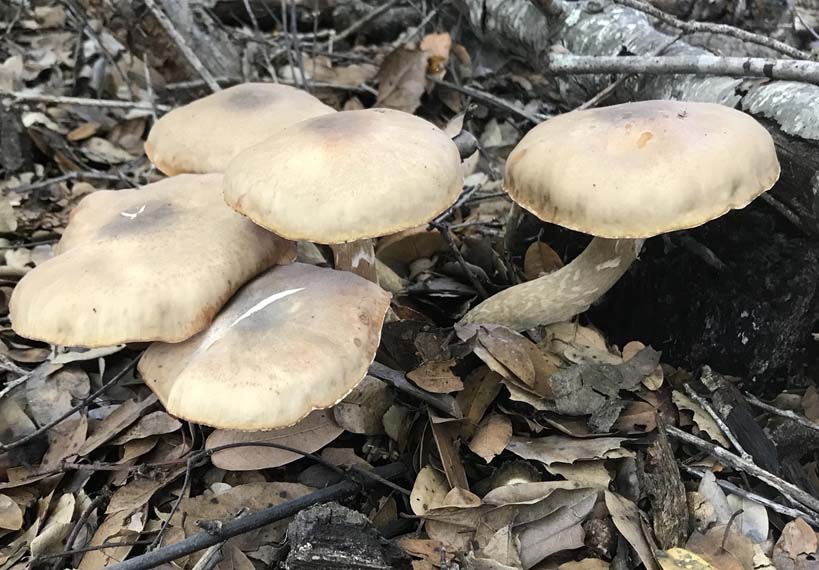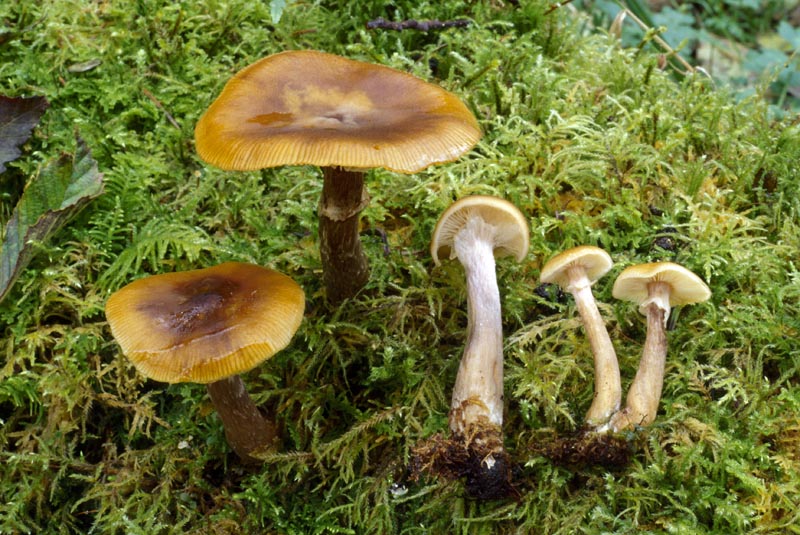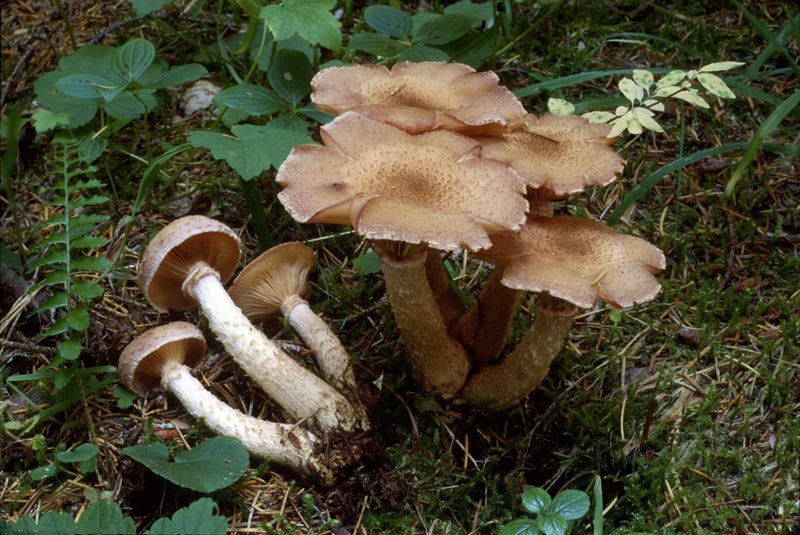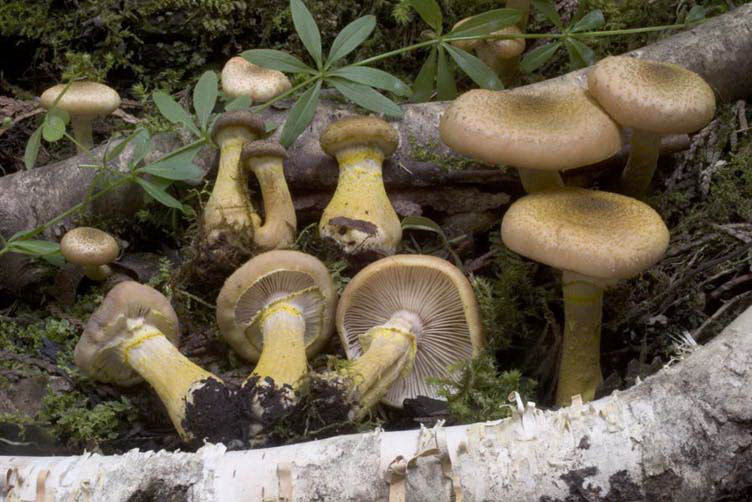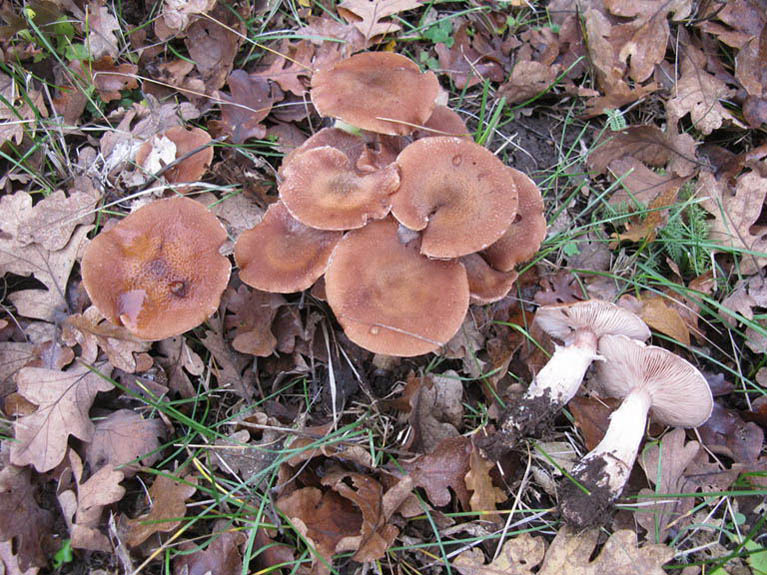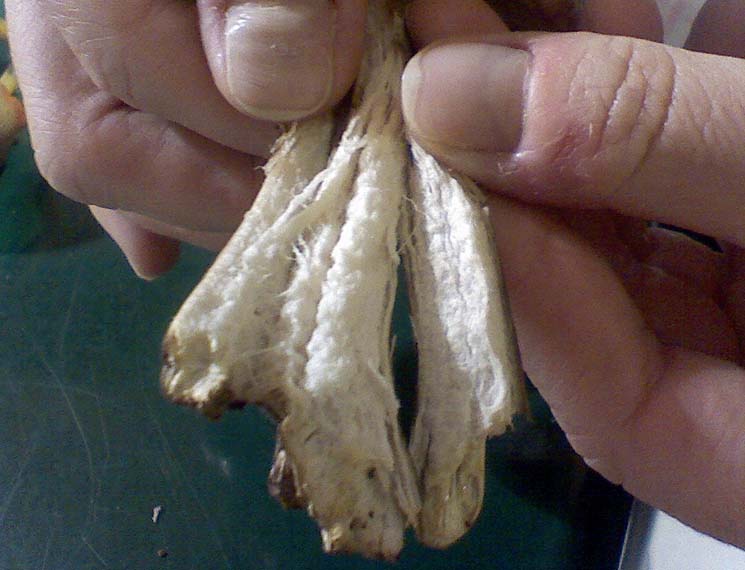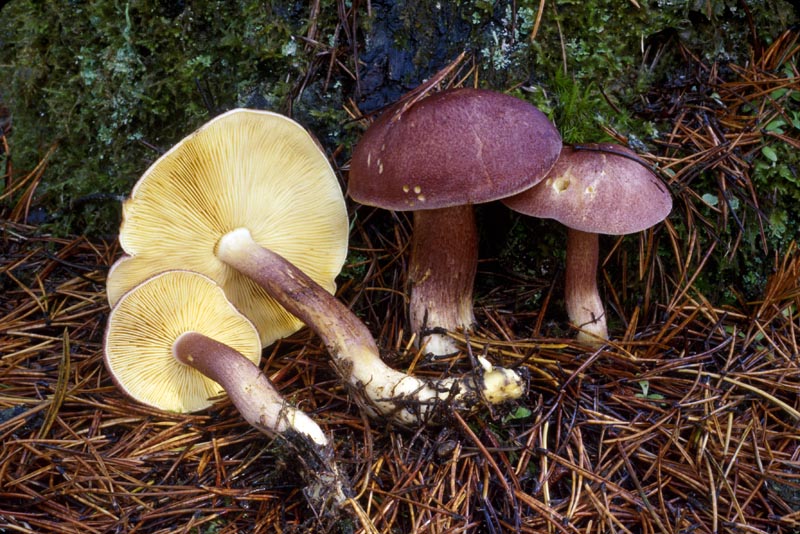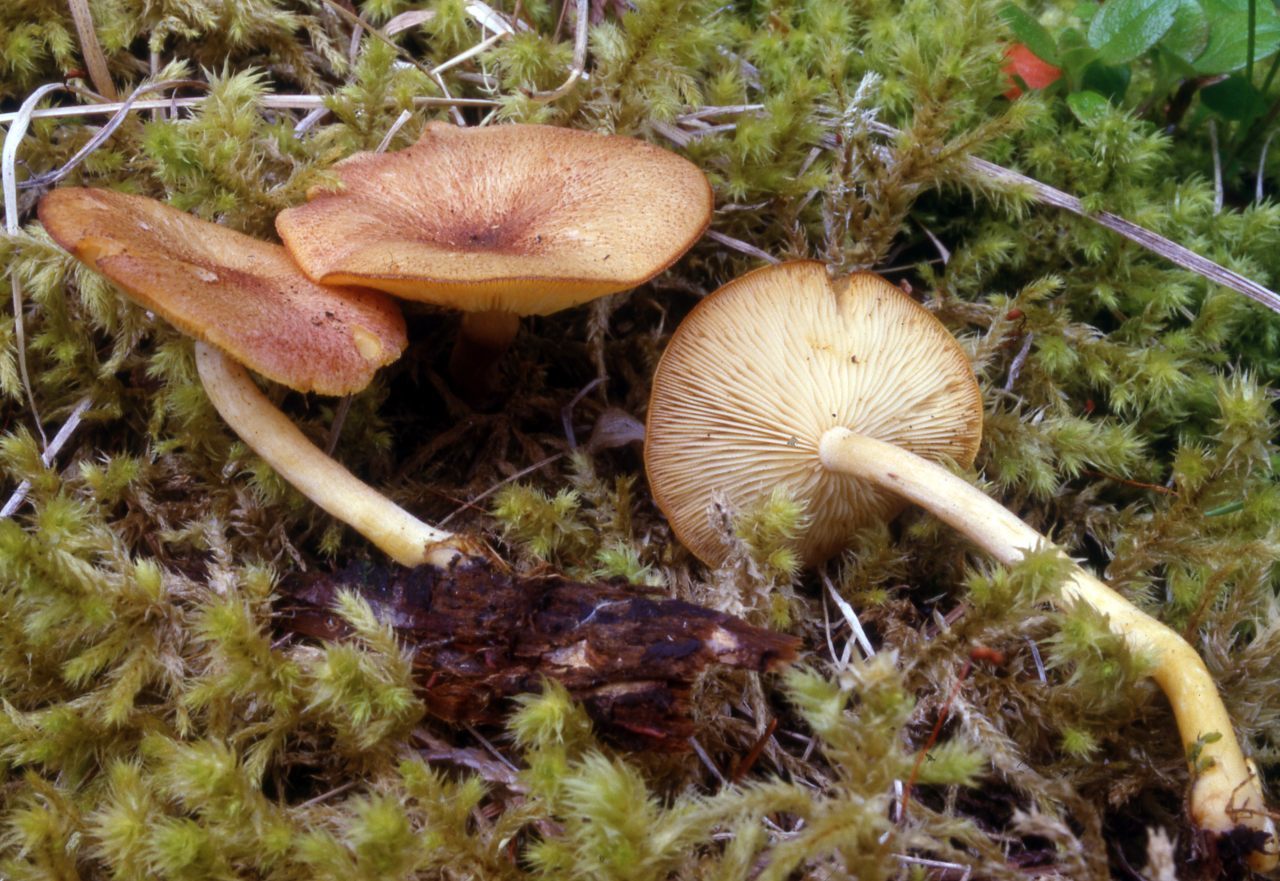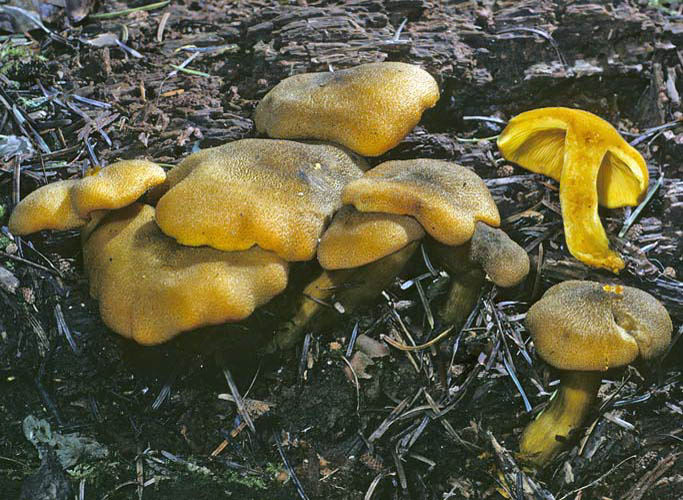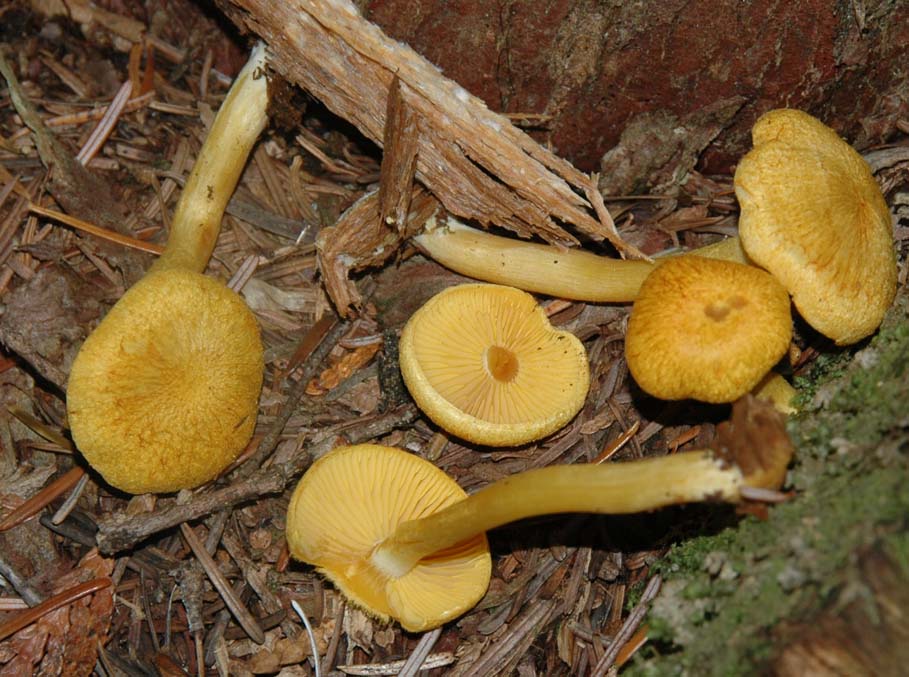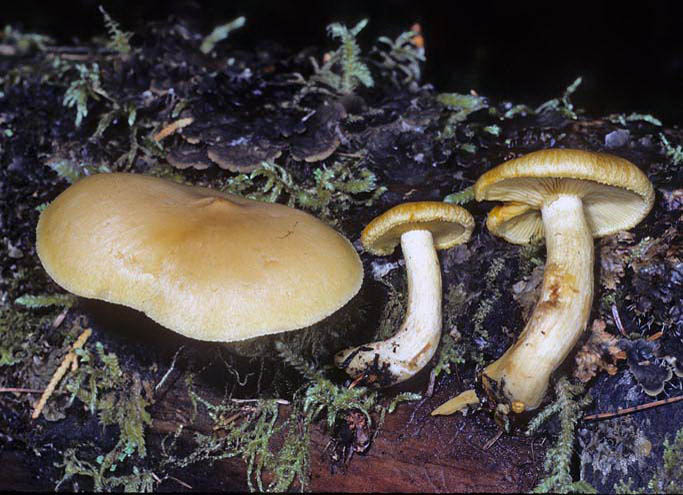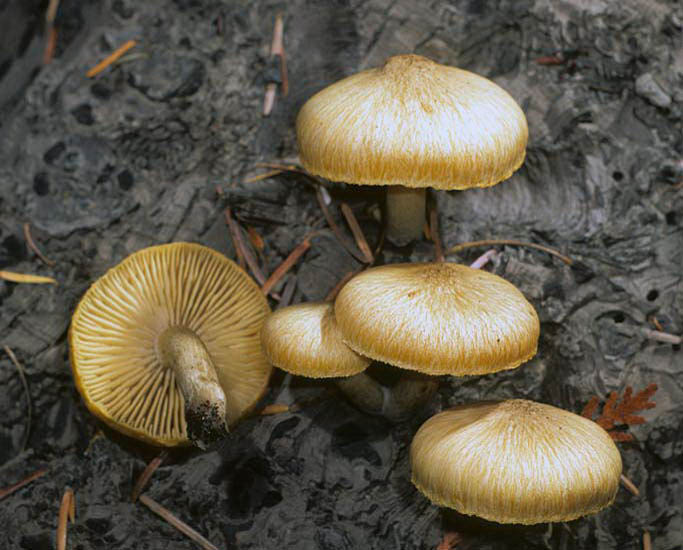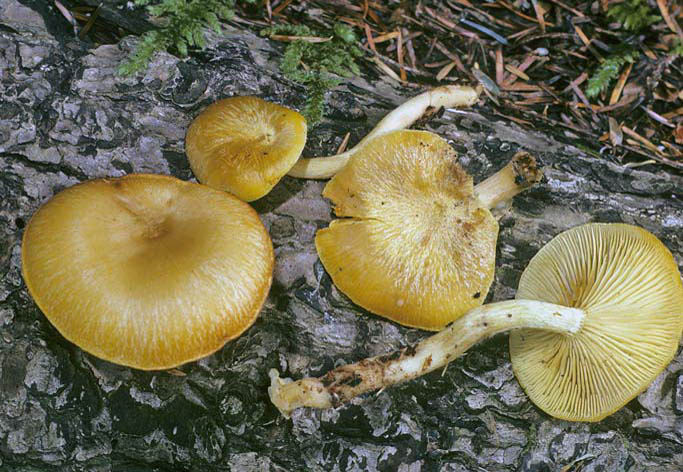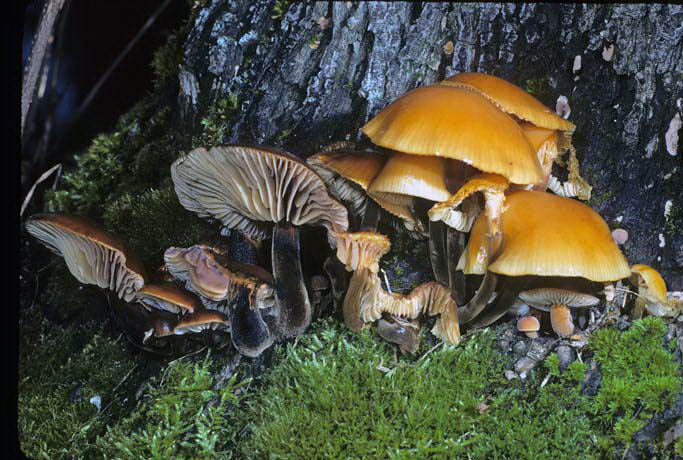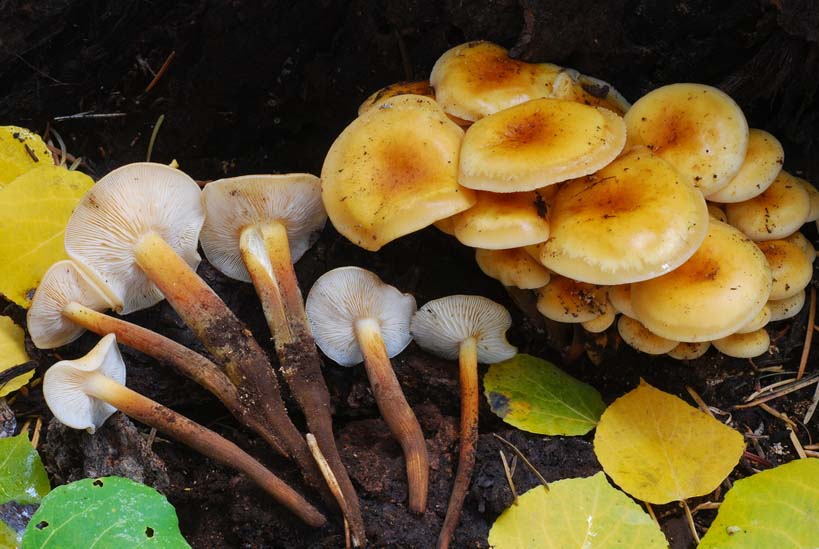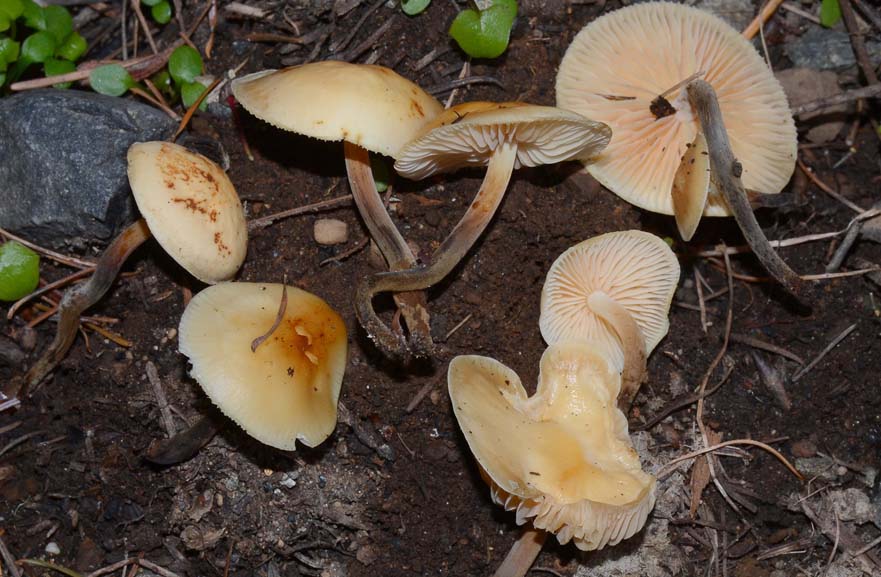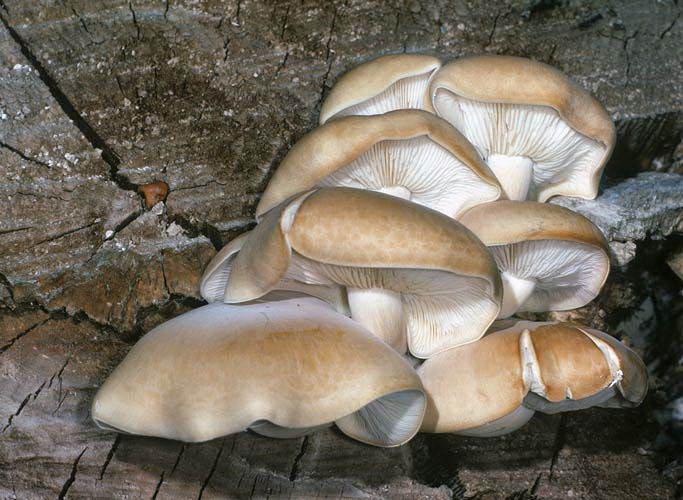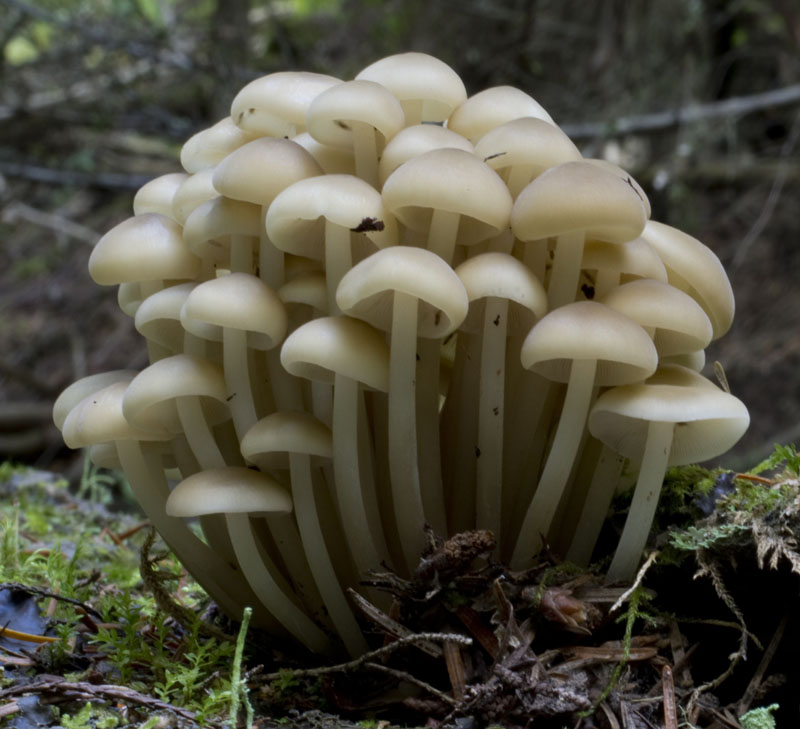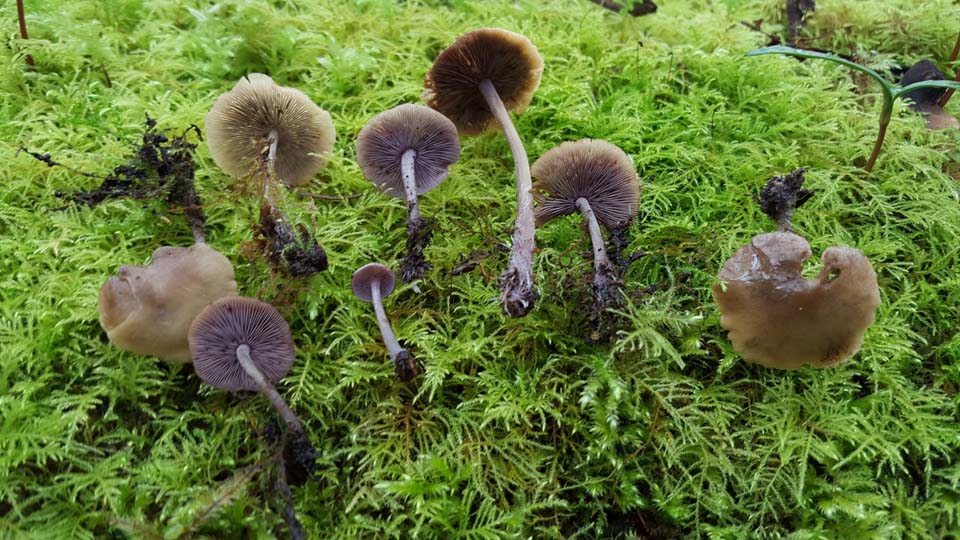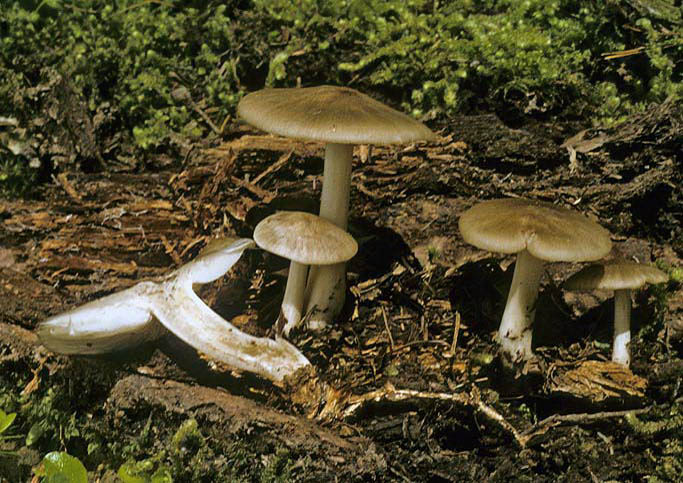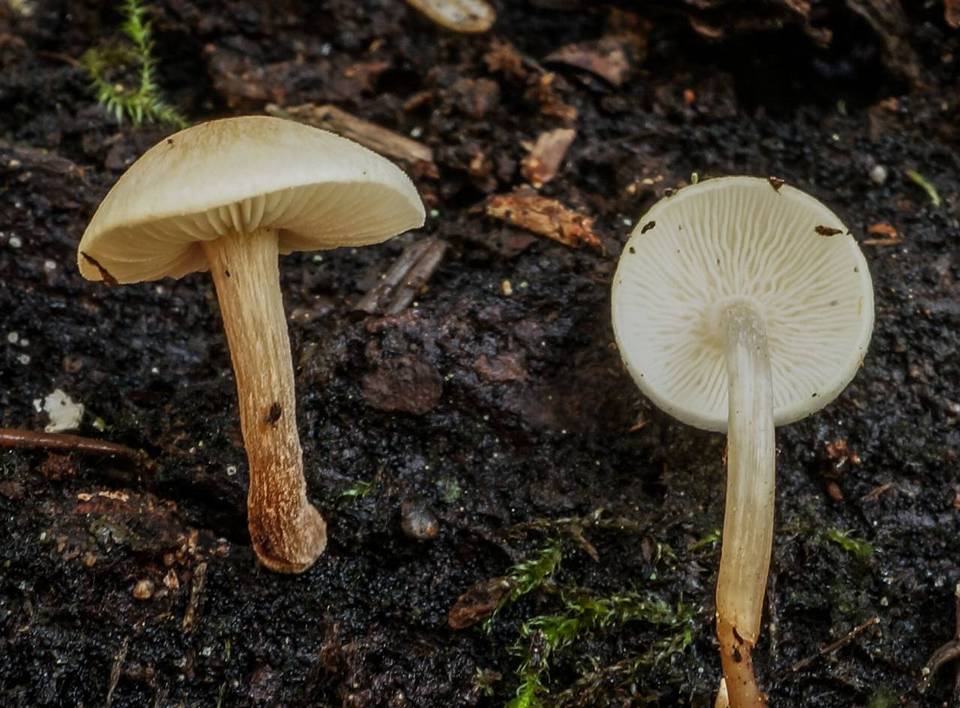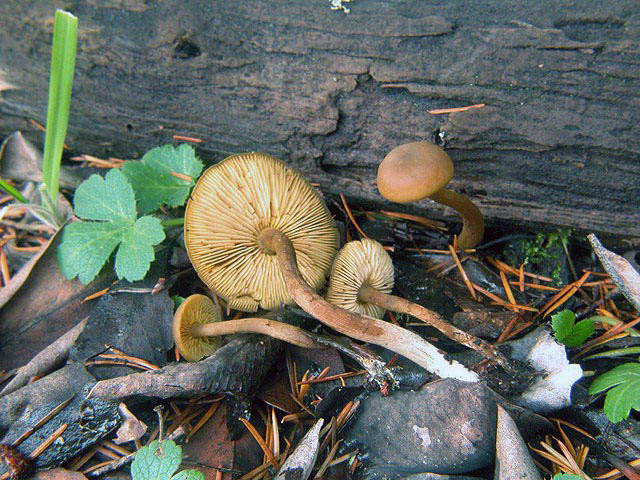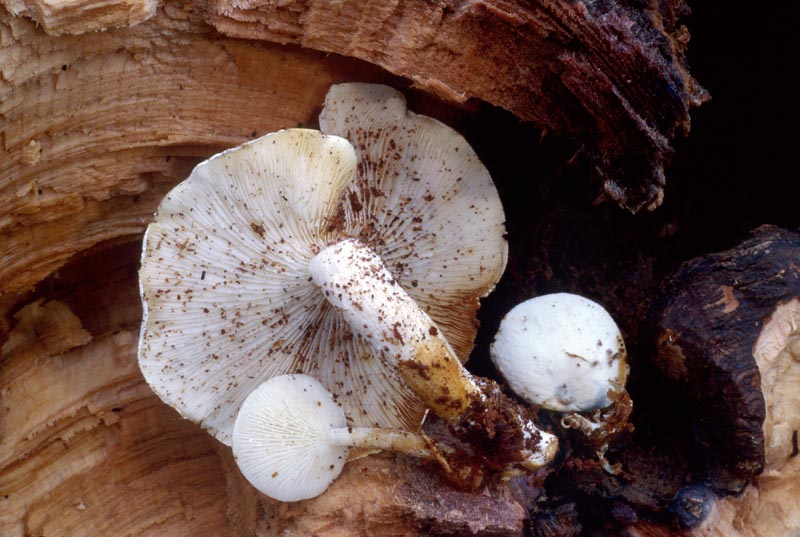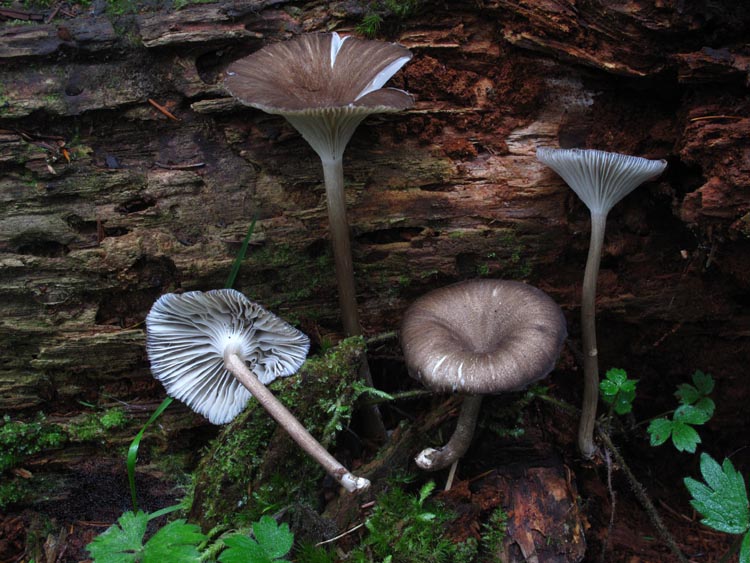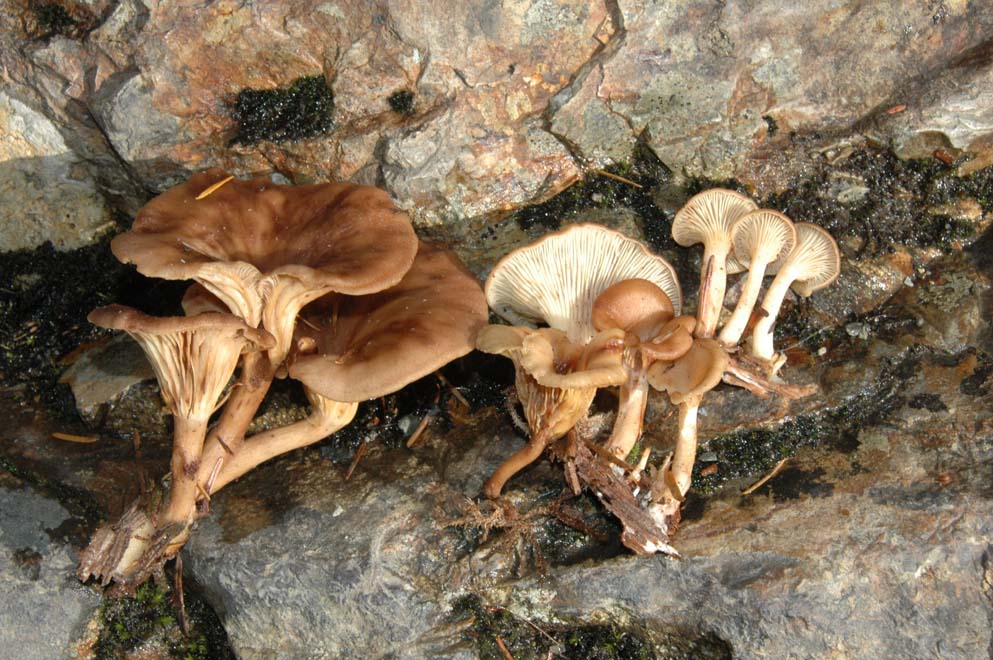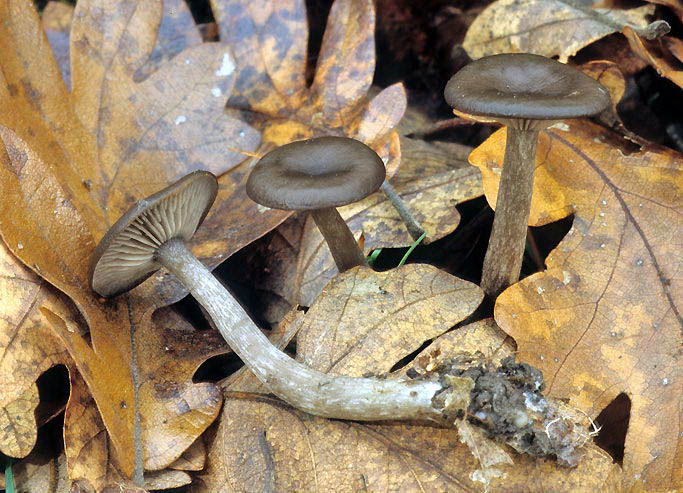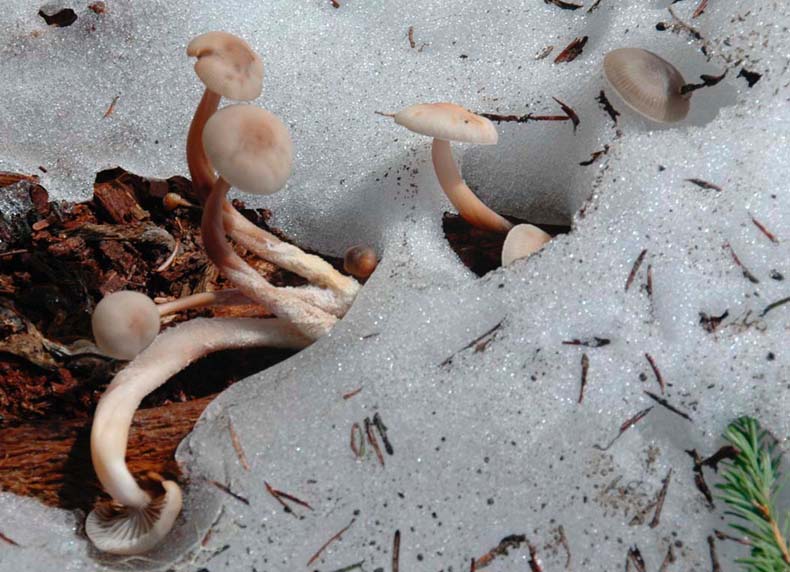Miscellaneous white spored Wood-inhabiting Mushrooms
All are saprophytic (or parasitic!)
on conifers (or not fussy) unless otherwise specified.
| Pleurotus/Panus are
large mushrooms on wood that usually have eccentric stems/tough
fruitbodies, and therefore are found on the Oddballs page, but they
might appear normal and be looked for on this page.
Neolentinus/Lentinellus
have serrated gill edges, but that is easy to overlook. |
| Gymnopus and
other collybioid fungi with tough stems can sometimes be found on
wood. Consider them too. |
| Also consider two small (<5cm) rare, whitish,
decurrent
Clitocybes that grow on wood. (C.
americana and C. truncicola) |
Key:
- Armillaria - large, partial veil often leaving a ring, often
scaly. Stem
looks stuffed with cotton.
- Tricholomopsis - beautiful bright yellow or pink mushrooms with
fibrillose to scaly caps.
- Flammulina - orange-brown,
somewhat viscid caps with blackish velvety stems found on
hardwoods.
- Other - Notched/Adnate - miscellaneous genera
with notched to adnate gills.
- Other - Decurrent
- miscellaneous genera with decurrent gills.
Armillaria - the honey mushrooms, popular edibles,
but there are now a half a dozen local species that have been
acknowledged in the last decades and some people react negatively to some of them (with some
people thinking that Armillarias growing on hardwoods are more likely to upset
your stomach, but guidebooks in Europe say the opposite, so who knows. Perhaps
they are all potentially poisonous). The
previously unknown different species have led to this mushroom getting the
nickname "The mushroom of a thousand faces", as there may or may not
be a lot of scales on the cap and stem, a well developed
ring
or just a slight partial veil, and they can range from small to quite large.
But they will always be larger than most other mushrooms in this
category, almost always have some kind of a partial veil and a stem that looks like it
was stuffed with a cottony pith. They grow on wood (sometimes buried and
appearing from the ground) sometimes in large clusters and are in the
Marasmiineae sub-order. A very common parasite. Usually 5-10cm except for the
larger species. Many species have glow in the dark mycelium
(bioluminescence).
A. mellea - pale, stocky, fall, in large clusters, the only species
without a bulbous stem base. Southern species. Hardwoods?
A. nabsnona - slender, bright orange-brown cap with
few cap scales, spring or fall, prefers alder.
A. altimontana - high elevation Rocky Mountain species.
A. solidipes (ostoyae) - stout,
dark or pale brown, much scalier. (usually conifers),
usually with the most developed ring of any species.
A. sinapina - like A. solidipes, but more often with golden
yellow universal veil remnants.
A. gallica - somewhat scaly, hardwoods.
A. cepistipes - somewhat scaly. The only one noted to sometimes have marginate gills. Hardwoods.
The cottony pith inside the stem of Armillaria
spp.
Tricholomopsis - very beautiful colourful
mushrooms on wood. Probably in the Pleurotineae, which is normally filled with
"oyster" species. Usually around 5cm.
T. rutilans - pink with black scales (both cap and stem),
bright yellow gills. Resembles Gymnopilus luteofolius.
May get >5cm and somewhat stocky.
T. 'flammula' - pink and black scales on cap only,
stem is yellow. More slender. WA/ID border.
T. decora group - bright yellow everywhere with
black scales. The rest of the yellow species don't have black
scales.
T. flavissima - gill
edges are yellow marginate, weak partial veil.
T. flavescens (thompsoniana) - flesh stains yellow when
handled. Balder cap than the others.
T. bella - gills and stem stain brown when handled.
T. fulvescens - stem stains yellow-brown, weak partial veil.
T. sulfureoides - a rather nondescript species (although still a beautiful yellow).
Also a weak partial veil.
Flammulina - this is what Enoki looks like in
the wild, and the amazing morphologic change into a all-white, needle-thin, long stemmed
mushroom with a pinprick head is an astonishing example of
how environmental conditions can change a species. They are on the small side
(<5 cm),
with a dark velvety stem when mature (and difficult to ID before then).
Somewhat viscid orange-brown cap that is not hygrophanous, growing on hardwood. Not uncommon
year round. Related to Armillaria (above) and
Strobilurus. Japanese growers (who are
usually heavy consumers) of this mushroom in Nagano were found to have much
lower cancer rates than those in other Japanese provinces.
F. filiformis
- our most common species (and the real cultivated Enoki species) is
this, not F. velutipes as long thought.
F. velutipes - may occur here as well
F. lupinicola - from CA on lupine, also in southern OR.
F. populicola - usually growing on cottonwood/aspen.
F. rossica - perhaps paler.
Other miscellaneous mushrooms - usually adnexed to adnate gills.
Hypsizygus tessellatus - the store bought "elm oyster".
Tan cap with water spots. May be farinaceous. Hardwood.
Not hygrophanous. Related to Lyophyllum.
Clitocybula familia - tan (to grey), very clustered. Resembles Mycena overholtsii.
Usually <2.5cm. Marasmioid clade. Amyloid spores (darkening in
iodine).
Clitocybula abundans/lacerata - grey, sometimes streaked. Less clustered,
slightly umbilicate. ~5cm. Gills may be decurrent.
Baeospora myriadophylla - found on logs,
crowded purple gills keep their colour longer than the rest of this
purple-tinged mushroom. Marasmioid clade.
Megacollybia fallax (platyphylla grp) -
large (but <10cm) grey-brown cap sometimes with
radial streaks that split, gill edges that might get eroded
in age, and some white rhizomorphs at the stem base. Not hygrophanous. Marasmioid
clade.
Gymnopus (Collybia) bakerensis -
<4cm. Mostly white with a pinkish brown stem base, growing on wood. Less
crowded gills than Ossicaulis. Not hygrophanous.
Callistosporium graminicolor ('luteoolivaceum') - a kind of
greasy olive yellow-brown. Not hygrophanous. Hard to ID,
especially when the olive colour has faded or when growing from the ground
from buried wood. In the Tricholomatoid clade.
5cm or less.
Usually decurrent gills.
Ossicaulis 'lignatilis' - pure white, crowded gills
of variable attachment. Stem sometimes off centre. Resembles Clitocybe truncicola and
Collybia bakerensis, but is purer white in
age with a stronger fungal-farinaceous odor. Hardwoods. Not hygrophanous.
Related to Lyophyllum.
Gerronema atrialbum (Clitocybula atrialba) - distinguished from
Clitocybe by its
long thin stem, thin flesh and dark cap and stem. On hidden
hardwood but appearing terrestrial. Marasmioid clade.
<10cm. Not hygrophanous.
Pseudoarmillariella ectypoides -
Strongly decurrent, yellowish
gills. Not
hygrophanous. Hygrophoraceae. It does somewhat resembles the smaller
Chrysomphalina
chrysophylla, which is more colourful and less strongly decurrent. 5cm or less.
Amyloid spores.
Pseudoclitocybe cyathiformis - resembles
Arrhenia,
Gerronema atrialbum and
Ampulloclitocybe with its dark cap and stem and
is also found on
buried wood growing from the ground, but is not usually as dark
or tall or thin-fleshed. Hygrophanous. Tricholomatoid clade. Around 5cm.
Amyloid spores.
Again, as this is a miscellaneous page, there is no specialized
literature available for this artificial group.
